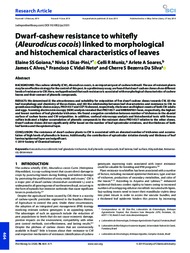Dwarf-cashew resistance to whitefly (Aleurodicus cocois) linked tomorphological and histochemical characteristics of leaves.
Dwarf-cashew resistance to whitefly (Aleurodicus cocois) linked tomorphological and histochemical characteristics of leaves.
Author(s): GOIANA, E. S. S.; DIAS, N. da S.; MUNIZ, C. R.; SOARE, A. A.; ALVES, J. C.; VIDAL-NETO, F. C.; SILVA, C. S. B. D.
Summary: The cashewwhitefly (CW), Aleurodicus cocois, is an important pest of cashewin Brazil. The use of resistant plants may be an effective strategy for the control of this pest. In a preliminary assay,we found thatdwarf-cashewclones showdifferent levels of resistance to CW.Here,we hypothesized that such resistance is associated with morphological characteristics of cashew leaves and their content of phenolic compounds. We determined (i) the attractiveness and suitability for oviposition of five dwarf-cashew clones towards CW, (ii) the leaf morphology and chemistry of those clones, and (iii) the relationship between leaf characteristics and resistance to CW. In greenhouse multiple-choice assays, PRO143/7 and CCP76 showed, respectively, the lowest and highest counts of both CWadults and eggs. Scanning electron microscopy (SEM) analysis revealed that PRO143/7 and EMBRAPA51 have, respectively, the highest and lowest numbers of leaf glandular trichomes.We found a negative correlation between number of trichomes in the abaxial surface of cashew leaves and CW oviposition. In addition, confocal microscopy analysis and histochemical tests with ferrous sulfate indicated a higher accumulation of phenolic compounds in the resistant clone PRO143/7 relative to the other clones. Dwarf-cashew clones did not significantly differ based on the number of leaf epicuticular striations, and the thickness of both leaf lamina and the epidermal layer. The resistance of dwarf-cashew plants to CW is associated with an elevated number of trichomes and accumulation of high levels of phenolics in leaves. Additionally, the contribution of epicuticular striation density and thickness of leaf lamina/epidermal layer are insignificant.
Publication year: 2019
Types of publication: Journal article
Unit: Embrapa Cotton
Observation
Some of Embrapa's publications are published as ePub files. To read them, use or download one of the following free software options to your computer or mobile device. Android: Google Play Books; IOS: iBooks; Windows and Linux: Calibre.
Access other publications
Access the Agricultural Research Database (BDPA) to consult Embrapa's full library collection and records.
Visit Embrapa Bookstore to purchase books and other publications sold by Embrapa.

